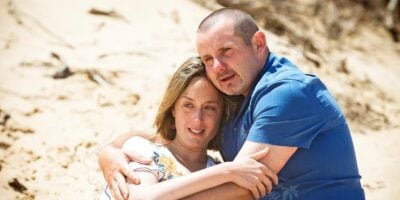For many animators, winning an Academy Award for your craft would be a career highlight.
But when Michael Dudok de Wit won his back in 2001, there’s no way he could have anticipated the phone call from Studio Ghibli asking him if he was interested in making a feature. The resulting collaboration led to the production of The Red Turtle, the first non-Japanese film Ghibli has produced and also one of the most heartfelt and mysterious stories you’ll find this year, and one entirely without dialogue, at that. Featuring a man stranded on a remote island and a giant turtle that transforms into a woman, the story is unique, but also ranks as another entry in a long tradition of fables depicting animals who become human.
“I had an addiction to fairy tales as a child,” de Wit recalls, “and it’s a theme that comes up everywhere. If you kiss the frog, you get the prince. It’s also within Greek mythology and Celtic mythology, and indeed in Japanese tales, which I only found out about much later. They have a very strong sense of it.
“I’ve got a personal theory about why [these stories persist], which sounds a bit silly if I put it into words. I grew up in a society where animals very much have their place, and are established in their place. A pony is a pony, a spider a spider. They have a neat place, and that is confirmed. A cow belongs on a farm, et cetera. I grew up in that and felt at peace with that, but I also was very much in touch with nature. I felt a fine sensitivity that animals don’t just have their set place. As a child I talked to trees, and it was perfectly normal, and I’ve kept some of this as an adult. We have another communication with nature, which is much finer, but as soon as you try to describe it, it sounds silly. So I responded to that by writing the story. I thought it would be beautiful to naturally tell the story that an animal can be a human being, and vice versa. I’m going to try and tell it as naturally as possible.”
For de Wit, storytelling is evidently a natural, imperative act – one that requires suspension of disbelief and for the artist to simply sink into the world of the film. However The Red Turtle isn’t completely divorced from reality, and the film features a subtle ecological commentary, addressed in the slow maturing of the main character’s relationship to both the island and to his remarkable companion. The sense of pacing throughout is incredible, and although the movie is set over many years and depictive of a life that is by necessity repetitious, the film never comes close to being monotonous itself.
“Repetition is something that I adore, that I use in my short films too. Not as a technique, because it can very quickly fall flat and look like a cheap trick,” de Wit laughs. “But I see repetition as something we live deeply anyway. Our days and the seasons have a rhythm. When there is rhythm in life, you adjust to it; you kind of let yourself be carried by it. Ideally, when something is rhythmic there should be an evolution. Gradually, things change.
“For instance, every day is the same for me: I wake up, I do my things, I go to bed, but every day is slightly different to before. It is slowly evolving. Film is something I find very beautiful when people use that, and in fairy tales and written fiction. When I wrote this story, I was initially aware that he was not going to try and leave the island just once. He now tries to leave three times, and the fourth is in an incomplete raft. There were going to be two more attempts originally, but it didn’t fit in the story, it became too repetitive.”
Given the reputation of Studio Ghibli, there will undoubtedly be many people excited to see how de Wit adds to the canon, and it would take a particularly cold heart not to be moved by this story. de Wit has long extolled Ghibli, and the way they “handle the presence of the mysterious”.
“It’s very easy to be mysterious, anyone can be mysterious. If there’s mystery in a film, it’s very conscious, and it may not work with every spectator. But I think it should be clear that this mystery belongs there, it has its place, it has its beauty. It doesn’t have to be rationalised.
“We all know what life is, we all know what love is. But they’re still naturally mysterious, and that’s the beauty of it. Of course, when you create a mysterious creature like the red turtle and do something mysterious with it, you want to make sure the audience go along with that. And so when I sent the first draft to the producers at Studio Ghibli, I was very sensitive to how they would react to the idea. Often I see films in a similar way to how you follow music. You just go with the flow, and don’t say, ‘But why did they play this instrument at this moment? Why is there this change of rhythm?’ You don’t ask these questions. You just get carried away by it.”
The Red Turtle opens in cinemas Thursday September 22.




































